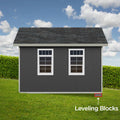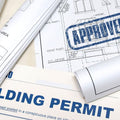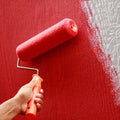Finishing Up: How to Paint and Caulk Your Shed

The first thing you should do after your new shed is installed is caulk and paint it. You will need to do this within 30 days of installation to prevent moisture from getting in. Caulking and painting are essential steps for extending your shed’s lifespan, protecting the things you keep inside, and validating the warranty. We’ve put together this guide to help you through the process and provide tips along the way.
Caulking Your Shed
Caulking seals any gaps, even unseen ones, between sections of wood. It will prevent the wood from shifting over time and keep water from getting inside. You’ll want to caulk first so that you can paint on top after it’s dry. This will give you cleaner results than if you were to caulk on top of your paint job.
What You’ll Need
Check your shed’s product specs and instructions to find out how many tubes of caulk you will need. We recommend acrylic latex caulk, as it is waterproof and paintable. You will also need a caulk gun.
These are the essentials, but there are a few extra materials that can make the job easier for you. Rubber gloves will keep your hands clean while you work. You can also keep a rag nearby to wipe off your hands or any drips.
Caulking Instructions
Depending on how big your shed is, it will typically take 4-6 hours to complete. Keep in mind that caulk takes about 24 hours to fully set once applied.
Look at the weather forecast ahead of time and avoid any chance of rain. If your caulk is exposed to water before it has had time to set and seal, it will be less effective at protecting your shed from water damage in the future. Once you have a good window of time, you’re ready to get started!
- Load your first caulk tube into the gun. Cut off a small piece of the tube’s nozzle using a sharp pair of scissors or a utility knife. Test the size of the caulk’s bead (the line of caulk as it leaves the tube), and snip further down the nozzle if necessary. Repeat this until the bead size feels right to you.
- When you’re ready to caulk, hold the gun at a 45° angle as you run it along each seam. Use a finger (gloved or not) to press and smooth the caulk into place after each line.

- Caulk all vertical seams where the wood panels of the shed meet each other.

- Caulk all around the top of the shed, underneath the trim. Be sure to cover the full perimeter, including the corners.

- Caulk the top of the horizontal trim above the door and the outer edges of the vertical trim to the left and right of the door. Make sure not to get any caulk in the door’s hinges.

- Caulk the horizontal seams where the upper and lower wall panels meet. This overlap will most likely be on the front and back of your shed, but you might find it on the left and right side walls depending on the door placement. Not all shed models will have this overlap.

- Caulk all vertical seams where corner trim is attached to the shed’s siding.

- Caulk all around the trim on the door’s face. Your shed’s door style might be different from the one shown in the diagram. Cover all seams where the trim is attached to the door panels.

- If your shed has windows, caulk around each window frame where it touches wood.

- Caulk to fill all nail and screw holes.
That’s all there is to it! Walk around the shed and look carefully to double-check that you didn’t miss any seams or holes. While it’s drying, avoid touching the caulk or the shed. If you get surprised by a rainstorm, cover the shed with a tarp to protect the caulk from getting wet before it has fully cured.
Painting Your Shed
24 hours after you finish caulking, you are ready to start painting. Aside from being a way of personalizing your shed, painting is also a way to extend the lifespan of your shed. Paint strengthens wood and protects it from dents, dings, scratches, and moisture. It also adds an extra seal on top of the caulk that you applied earlier.
What You’ll Need
Check your shed’s product specs and instructions to find out how much paint you will need. We recommend 100% acrylic latex paint designed for outdoor use. Most Shed Liquidators sheds come with factory-primed siding, but if any exterior wood on your shed is not primed, you will need to buy primer.
Other materials that you will need include paint rollers, a roller frame (or two if you want different lengths), brushes, wooden stir sticks, painter’s tape, paint trays, tray liners, and drop cloths or tarps.
Painting Instructions
Just like when you caulked, check your weather forecast and look for a 24-hour window of clear skies. If possible, waiting for 36 or even 48 hours is safer. Paint can feel dry to the touch before it is ready to get wet without streaking. The amount of time your paint takes to dry will depend heavily on the environment. For example, drying time will be faster in a dry climate and slower in a humid one.
- Begin by laying out drop cloths or tarps. Tarp keeps the stains off your patio or driveway and protects your grass from harmful chemicals. This is especially important if you have pets or kids that play outside.
- Use your painter’s tape to outline the siding. You will be able to peel up the tape later and reveal clean lines.
- Open your first can of paint. Stir with a wooden stir stick for at least a minute, or until it is visibly mixed. This will be easier to see with darker colors, so stir your lighter colors for longer than you think.
- Pour the stirred paint into a tray with a liner. A little can go a long way, so start by pouring less than you think you’ll need. Place the paint can lid back on top and use a hammer to pound it into place. Do this between every pour to keep the paint from drying out and to avoid spills.
- Use a paintbrush to cover the smallest areas where a roller won’t be able to reach and any edges that need to be handled with care.
- Use a paint roller to cover the large, empty areas. Where the roller can reach, go back over any areas that you covered in step 5 to smooth over the brush strokes. Peel off your painter’s tape before the paint is fully dry to prevent cracking edges.
- Do at least two coats, or more if necessary. Wait for each coat of paint to fully dry (24-48 hours) before doing another. Repeat the process on your shed’s doors and trim.
Once your shed is caulked and painted, it will be good to go for years to come! Fill it up and rest assured that your belongings will be safe and dry inside. Replace caulk and sand/re-paint every five years. If your paint is flaking or peeling, or if your caulk is cracking, that’s a sure sign that it’s time for some maintenance. Reach out to us with any questions you might have, and we will be happy to help.
Ready to find the right shed for you? Check out the models we offer at Shed Liquidators.






















